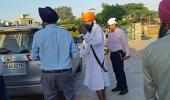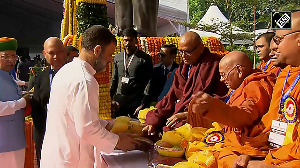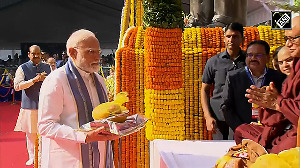There's an entire gurdwara dedicated to immigration.
People present tiny airliner models here in the hope that Waheguru will soon give them a ticket, passport and visa to leave, reveals Shekhar Gupta.

The six-part OTT series Kohrra, directed by Randeep Jha and created by Sudip Sharma that is currently streaming on Netflix, has its central character speak a line that's insightful as well as prescient about the state of Punjab.
Of course, such harsh truths are often spoken when both the speaker and the listener are at a high enough "spiritual" level.
Suvinder Vicky, playing sub-inspector Balbir Singh, the central character, tells his sidekick and pal assistant sub-inspector Amarpal Garundi (played by Barun Sobti), "Tainu pata hai Punjab dee tragedy kee hai? Sadda mitti paawo attitude. Assi case solve nahiyon karna. Bas band karna hai."
My best effort at translation would be: Do you know what our Punjab's tragedy is? Bury the truth, and move on. We won't solve a case. We'd rather close it and be done with it.
Of course, the context in this case is a serious investigation into multiple murders in a complex web of emotion, many strands of sexuality, immigration, and at least four awfully dysfunctional Punjabi Sikh families.
Balbir is bemoaning the fact that he's under pressure from the bosses who want to wrap up the case by charging just the obvious, lowly suspect, while he thinks the real perpetrators are much higher up.
It's the season of Punjab in popular culture -- there have recently been several movies and OTT serials, not just the usual ball balle item number here and there.
Kohrra is sharp in that it takes a much wiser look than any we've seen or read lately at the consequences of a two-decade stall and relative decline in this critical border state.
This is so creatively insightful that you wonder how come some of the same key film-makers made that super-idiotic Udta Punjab.
This one also has a similar mix: Drugs, hormones, class, patriarchy, misogyny and crime.
But without the exaggeration and noise, it is much closer to reality, and makes you think.
Particularly at a time when we have seen a new government in Punjab trying new ideas, and the prime minister making an outreach to the Sikhs in every major speech.
That there is concern about Punjab is a good thing.
But the solution is not merely to make sympathetic noises, express solidarity, offer another 20,000 jobs, free power or praise the religion, underwrite pilgrimages and so on.
All that would amount to what Balbir Singh is complaining about: 'Mitti paao...'
All the multiple tragedies that Kohrra is built around are rooted in the proud state's stall and decline over the past quarter century.
The Punjabis know how to weather adversity. They did so after Partition, and later after the phase of terror and militancy ended in 1993.
Then, the state lost its way. It missed the post-1991 industrial revolution.
It used to be India's number one, or richest in per capita income, until 1999-2000.
Now it is number 13. Or number 12, if we confine our comparisons to the 21 states with GDP above Rs 1 trillion.
This would remove Goa, the richest state but a tiny one.
At Rs 1.69 lakh per capita, Punjab has fallen way behind its two separated siblings Haryana (Rs 2.65 lakh) and Himachal Pradesh (Rs 2.0 lakh).
Telangana, by the way, tops the list at Rs 2.7 lakh, followed by Karnataka, Haryana, Tamil Nadu and Gujarat. What's common is easy to see.
Each of these states has urbanised generally but also built major urban centres that became magnets for new economy industries.
A similar story plays out with the rates of GDP growth over the past 10 years (2011-12 to 2021-22).
Among the 21 major states with trillion-rupee-plus economies, Punjab is sixth from the bottom with 5 per cent GDP growth.
In the same decade, Gujarat topped with 8.4 per cent, while Karnataka and Haryana were second and third with 7.3 per cent and 6.7 per cent, respectively. And you know what?
The much-maligned 'Bimaru' constituent Madhya Pradesh is bracketed fourth with Haryana.
Punjab, hold your breath, languishes at the same level as Bihar on the growth rate chart.

Punjab has remained trapped in farming. It has many cities, but all indicators would show it is still essentially a rural state.
The fact that so much popular culture, especially the Yash Chopra genre, has romanticised its lush fields, mustard, music and extroverted 'If-you-got-it-you-flaunt-it' style, does not change the reality that Punjab is a state in deep decline, living on past glory.
If anything, its deep, often boisterously expressed, pride and self-esteem are now facing a brutal reality check.
Which explains drugs at one end, and the madness for emigration at the other.
Manufacturing, services, and even the big job creators like apparel and hosiery either haven't come up or have declined.
Agriculture now accounts for about 30 per cent of Punjab's state GDP (GSDP), which is the same as Rajasthan and only behind Madhya Pradesh (44 per cent), Andhra Pradesh (36 per cent).
All these states have one thing in common with Punjab: They haven't created new urban magnets for investment, talent and growth.
Punjab might still have at least slowed its decline if only its farm sector was growing like its peers.
It is now way, way slower than even Madhya Pradesh.
The same balle balle smugness that led to its decline in so many sectors -- including sports -- has marked farming as well.
That the state was at the forefront of the anti-farm law movement underlines that story.
No state needed agricultural reform more than Punjab, given the talent and entrepreneurship of its farmers that created the Green Revolution.
Yet, none was more opposed to it. It came from broken politics, decades of frustration and the single-focus evolution of its entrepreneurial virility: Emigrate, emigrate, emigrate.
The grim picture this data paints of Punjab won't be evident to a visitor. Punjab, actually, has very little visible poverty.
No slum sprawls, kutcha homes in villages, destitution.
This doesn't have to be counterintuitive, as there is data to support this too.
The percentage of people below the poverty line at 4.75 per cent is among the lowest in the country.
Of the major states, only Tamil Nadu and Kerala are doing better. This is poverty as measured by NITI Aayog's latest multidimensional poverty report and ratings.
Where is the problem then?
Punjab also has among the lowest inequality levels in India. So far, so good.
But if its overall GDP has stalled, it also implies that it also has too few rich people.

This column was also sparked by an opinion piece on Kohrra in The Indian Express by Allahabad University faculty member Smriti Suman, who used the expression 'neoliberal' twice to underline what ails Punjab.
That led us on a search for data, which shows the opposite.
That far from being a victim of too much neoliberalism, the trap in which Punjab is caught can only be described as agrarian-feudal patriarchy.
If anything, the state can do with a dollop of neoliberalism to break out of this.
Or, given its lack of poverty, inequality and the absence of the really wealthy, you could also see it as a socialist utopia.
The Punjabis don't want it. They're fleeing it.
There's an entire gurdwara (Talhan, along Grand Trunk Road) almost across from the Lovely Professional University Campus near Jalandhar, dedicated to immigration.
People present tiny airliner models here in the hope that Waheguru will soon give them a ticket, passport and visa to leave.
Bristling at one such 'misdemeanour' at the Golden Temple, the Shiromani Gurudwara Prabandhak Committee, on the advice of the Shri Akal Takht Sahib, asked devotees to desist from doing any such thing again.
It is just that these are just airplane miniatures that cost a couple of hundred rupees apiece.
Veera Soni of Kohrra is willing to dump a boyfriend she loves to embrace an 'arranged' UK NRI, and when he's murdered, yet another within a fortnight, from Canada.
The leaders of Punjab have failed it, and its people want out.
By special arrangement with The Print
Feature Presentation: Aslam Hunani/Rediff.com












 © 2025
© 2025